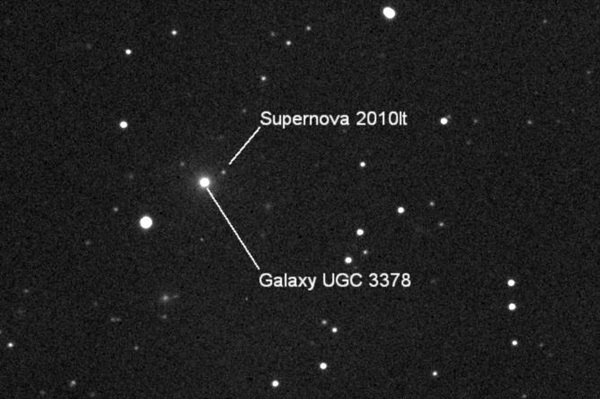A 10-year-old Canadian girl has become the youngest person to discover a supernova. Kathryn Aurora Gray of Fredericton, New Brunswick, along with longtime astronomy enthusiasts Paul Gray (Kathryn’s father) and David Lane, found a magnitude 17 supernova, dubbed supernova 2010lt, in the galaxy UGC 3378 in the constellation Camelopardalis, as reported on the International Astronomical Union Electronic Telegram 2618. Lane imaged the galaxy on New Year’s Eve 2010, and Kathryn and Paul discovered the signs of the supernova in the image January 2, 2011.
Supernovae are stellar explosions that signal the violent deaths of stars several times more massive than our Sun. They are interesting to astronomers because they manufacture most of the chemical elements that went into making Earth and other planets, and also because scientists can use distant supernovae to estimate the size and age of our universe.
Supernovae are rare events. The last one in our galaxy occurred several hundred years ago, before the invention of the telescope. The odds of discovery can be increased by repeatedly checking many other galaxies. A new supernova reveals itself as a bright point of light that wasn’t there the last time the galaxy was checked. Because a supernova can outshine millions of ordinary stars, it is easy to spot with a modest telescope, even in a distant galaxy like UGC 3378, which is about 240 million light-years away.
The discovery was soon verified by Illinois-based amateur astronomer Brian Tieman and Arizona-based Canadian amateur astronomer Jack Newton. It was then reported to the International Astronomical Union’s Central Bureau for Astronomical Telegrams. This is Lane’s fourth supernova discovery, Mr. Gray’s
seventh, and Kathryn’s first.
A 10-year-old Canadian girl has become the youngest person to discover a supernova. Kathryn Aurora Gray of Fredericton, New Brunswick, along with longtime astronomy enthusiasts Paul Gray (Kathryn’s father) and David Lane, found a magnitude 17 supernova, dubbed supernova 2010lt, in the galaxy UGC 3378 in the constellation Camelopardalis, as reported on the International Astronomical Union Electronic Telegram 2618. Lane imaged the galaxy on New Year’s Eve 2010, and Kathryn and Paul discovered the signs of the supernova in the image January 2, 2011.
Supernovae are stellar explosions that signal the violent deaths of stars several times more massive than our Sun. They are interesting to astronomers because they manufacture most of the chemical elements that went into making Earth and other planets, and also because scientists can use distant supernovae to estimate the size and age of our universe.
Supernovae are rare events. The last one in our galaxy occurred several hundred years ago, before the invention of the telescope. The odds of discovery can be increased by repeatedly checking many other galaxies. A new supernova reveals itself as a bright point of light that wasn’t there the last time the galaxy was checked. Because a supernova can outshine millions of ordinary stars, it is easy to spot with a modest telescope, even in a distant galaxy like UGC 3378, which is about 240 million light-years away.
The discovery was soon verified by Illinois-based amateur astronomer Brian Tieman and Arizona-based Canadian amateur astronomer Jack Newton. It was then reported to the International Astronomical Union’s Central Bureau for Astronomical Telegrams. This is Lane’s fourth supernova discovery, Mr. Gray’s
seventh, and Kathryn’s first.










